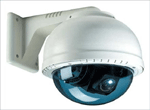
What is the cost of installing a cctv system?
There are a lot of variables that will affect that answer. Though the easiest way to find out is to get estimates on the cost of installing a cctv system from different contractors, knowing what questions to ask, what your exact needs are, and which options will lower the price the most while still providing you the level of surveillance you need will allow you to narrow your specifications down ahead of time and focus on what's important.
What are the items that affect the cost the most?
- The number and type of camera.
- The type of lens needed on each camera.
- Physical location of camera and whether it needs to be hidden or weatherproofed.
- How the system will be monitored, whether recorded or in person.
- The amount of cabling needed for installation.
- The cost of the installation.
The Cameras
You will have to determine the minimum number and placement of cameras before you can determine the type and size of the digital video monitoring system (DVR) you'll need. There are some variables to be considered here.
The first is whether you'll need analog or digital cameras. Analog cameras are much cheaper, but the resolution isn't nearly as good which results in a lesser quality video. Digital cameras or IP cameras also allow for many more additional features. The size and purpose of the system will help you make this decision.
The second is placement of your cameras. Outside cameras may need to have a weatherproof and/or vandalproof housing depending on where you place them. Hidden cameras, while more effective, are also more expensive.
There's also the dome camera vs. bullet camera debate. Dome cameras are usually mounted on the ceiling and are more vandal proof but their effective range is limited. When ordered with a smoked lens casing it's harder to see where the camera lens is pointed. Bullet cameras are usually wall mounted and have a greater range but can be more prone to vandalism and can more easily be avoided if seen by those who wish to avoid surveillance. The other advantage to a bullet camera is that they usually will come in a weatherproof case. Sometimes the choice between bullet or dome cameras is pretty clearcut but in other cases it's more difficult.
Once you've determined the number and type of cameras and their placement you'll then need to determine if a fixed lens is sufficient or if you'll need the ability to zoom or pan on one or more cameras. The ability to zoom and pan will add to the effectiveness of your system as well as the cost. This ability may be overkill on a small home system but could be critical to a large and complex business or warehouse surveillance system.
The Monitoring and Recording System
The number, type and featureset of the cameras you use will help determine the type and size of the monitoring system. The number of cameras you plan to run determines the number of channels you need on the DVR since each camera requires its own DVR channel. Do keep in mind that if you plan to grow the system in the future it may be prudent to purchase a DVR that has more channels than you currently need in order to allow for that growth. It's ultimately cheaper to bump up the capacity on this up front than to replace the DVR when you need to expand.
There are other features that will affect the cost and complexity of the DVR you purchase. Will you need a people counting feature? Will you need to perform facial recognition? Will you need infrared for low light situations? What recording capacity will you need? If the system is monitored live then will you need the person monitoring to have the ability to zoom or pan on a specific camera? Identifying and sticking to the essentials will give you the most bang for the buck.
Your Cabling Needs
The amount of cabling you'll need to run will figure into the price. Wherever there is a total length in excess of 500 feet from the DVR to the camera a video balun will be necessary to boost the video signal strength. Sometimes camera placement can be juggled a bit to avoid this expense if you're working close to that length. You'll also need to run wire for the power supply to each camera from your power supply box.
Installation Costs
If your system is a simple one with only one or two simple cameras, then you might consider this as a do-it-yourself project, but the results are rarely as good or as effective as a professional installation. Kits seldom contain quality components. Also, you might find that the price of a professional installation is cheap compared to the learning curve involved in troubleshooting your first installation.
Get a few estimates. Try to keep the system components comparable so you're comparing apples to apples, but keep an open mind if one of the technicians estimating the job makes specific recommendations due to the physical challenges of your location.
Conclusion
There is no "one size fits all" when it comes to the cost of installing a cctv system. Figuring out your exact needs will nail down your video surveillance system cost.

